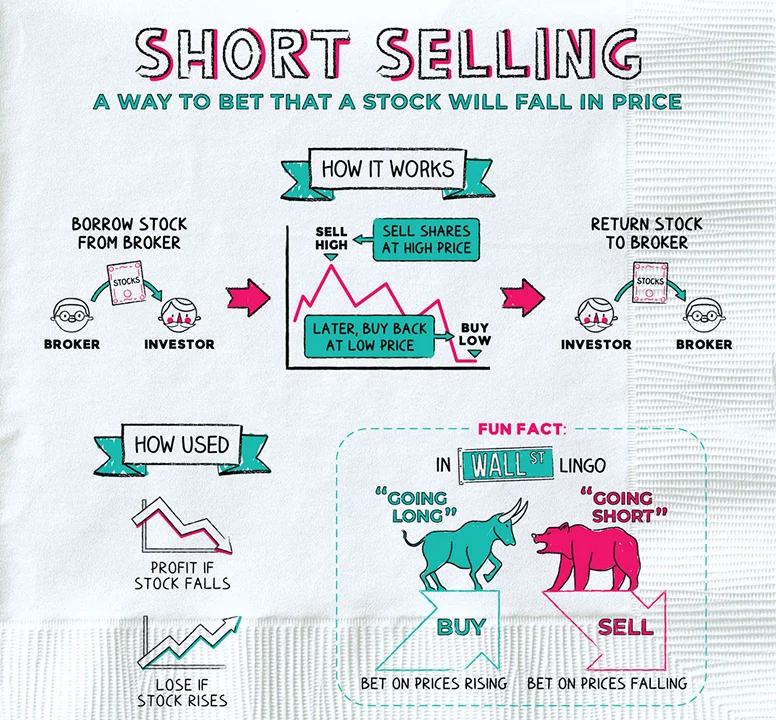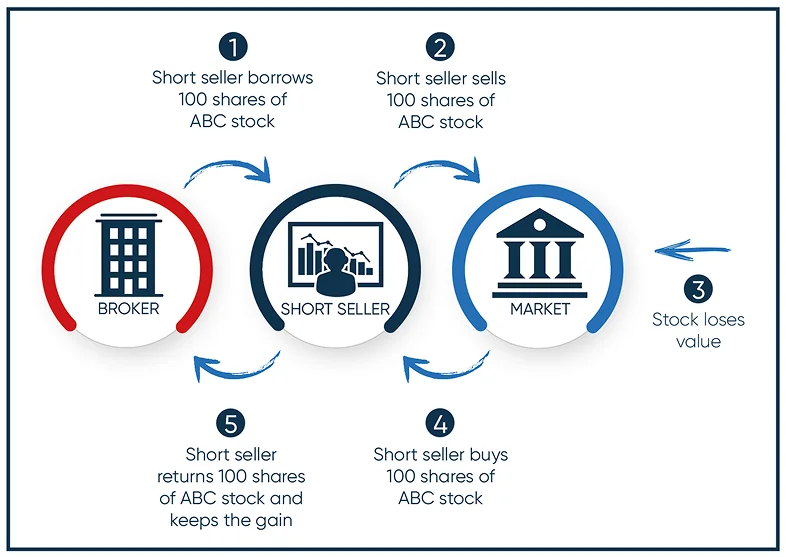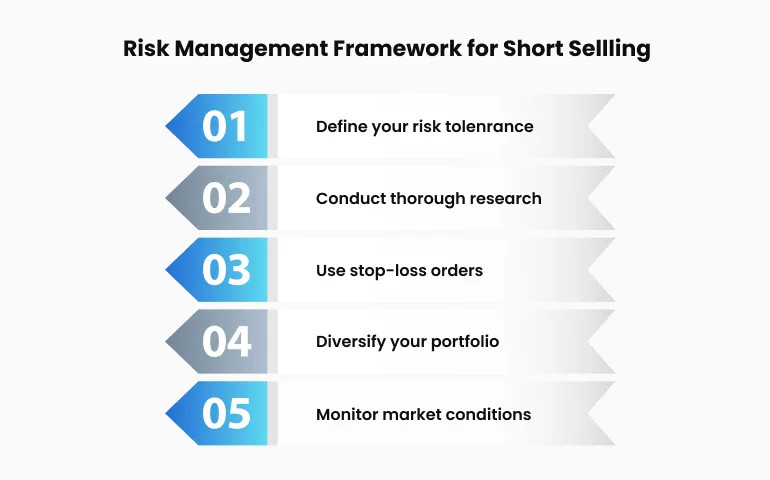

Short Selling: A Comprehensive Guide
Short selling is a sophisticated trading strategy where a trader borrows and sells a financial instrument, intending to buy it back later at a lower price to gain from the price decline. Although it offers substantial profit opportunities, short selling involves considerable risks, including the possibility of unlimited losses. A thorough understanding of short selling mechanics and appropriate application timing is crucial for traders aiming to benefit from bearish market conditions. This guide delves into the operational aspects, strategic approaches, risk factors, and advanced methodologies of short selling.
What is Short Selling?
Short selling, also known as shorting or going short, is a trading technique where an investor borrows an asset (typically from a broker) and sells it on the open market with the intention of repurchasing it later at a lower price. The objective is to generate profit from a decline in the asset's price.

Key Points
Short sellers seek to profit from declining asset prices.
This strategy involves borrowing assets to sell them, followed by repurchasing them later.
Potential gains are capped (as prices cannot fall below zero), whereas losses can be unlimited.
Short selling carries higher risk compared to traditional "long" investing.
It contributes significantly to market efficiency and price discovery.
Historical Context
Short selling has been practiced for centuries. One of the earliest documented cases dates back to 1609 when Dutch trader Isaac Le Maire shorted shares of the Dutch East India Company. Since then, short selling has often been controversial, especially during market downturns, sometimes resulting in temporary restrictions or bans in various jurisdictions.
How Short Selling Works

Borrowing
The trader borrows shares from a broker. These shares typically come from the broker's inventory, another client's margin account, or an institutional lender.
Selling
The borrowed shares are sold at the prevailing market price. The proceeds are credited to the trader's account, but this amount serves as collateral for the borrowed shares rather than realized profit.
Waiting
The trader waits for the asset price to decline. During this period, they may incur borrowing costs and are responsible for reimbursing any dividends paid to the original lender.
Buying Back
The trader repurchases the shares at the new, lower market price, a process known as "covering" the short position.
Returning
The shares are returned to the lender, thereby closing the short position.
Profit/Loss
The trader's profit or loss is the difference between the initial sale price and the repurchase price, adjusted for fees and any dividend payments.
Example

Suppose a trader believes that XYZ Corp's stock, currently trading at $100, is overvalued:
- They borrow 100 shares and sell them for $10,000.
- The stock price declines to $80.
- They repurchase 100 shares for $8,000.
- The gross profit is $2,000, excluding fees and dividend obligations.
Conversely, if the stock price had risen to $120, the trader would incur a loss of $2,000 plus associated costs.
When to Consider Short Selling
Overvalued Assets
When you assess that an asset's market price exceeds its intrinsic value, possibly due to inflated earnings, unsustainable growth forecasts, or speculative hype.
Negative News or Events
When anticipating adverse effects from forthcoming news or events such as disappointing earnings, regulatory shifts, or sector disruptions.
Technical Indicators
When technical analysis signals a potential price decline, such as bearish chart formations, momentum indicators, or moving average crossovers.
Market or Sector Downtrends
Traders can capitalize on broad market or sector-wide downturns during bear markets or when specific sectors underperform.
Pair Trading
As part of a strategy to profit from the relative performance between two correlated securities by going long on one and short on the other.
Hedging
To protect a long portfolio during market declines, a strategy often employed by institutional investors.
Arbitrage Opportunities
When price inefficiencies between related securities or markets are expected to converge.
Bubble Detection
When you identify a market or asset exhibiting bubble characteristics and anticipate a correction.
Fraud Detection
If you suspect fraudulent activity within a company, short selling can serve as a method to profit from and highlight such findings.
Short Selling Strategies

Fundamental Short Selling
Based on in-depth analysis of a company's financial health and business model to identify overvaluation.
Example:
Shorting a company exhibiting weakening fundamentals, such as declining revenue or rising debt levels.
Technical Short Selling
Utilizing chart patterns and technical indicators to identify optimal short entry points.
Example:
Shorting when a stock breaks below a critical support level or moving average.
News-Based Shorting
Responding swiftly to negative news that may adversely affect a stock's price.
Example:
Shorting a pharmaceutical company following an unsuccessful drug trial announcement.
Trend Following
Shorting assets that are exhibiting a sustained downtrend.
Example:
Using moving averages to identify stocks in long-term downtrends suitable for shorting.
Pair Trading
Shorting one asset while going long on a related asset to capitalize on relative performance differences.
Example:
Going long on Coca-Cola while shorting Pepsi, betting on Coca-Cola's relative outperformance.
Short Squeeze Anticipation
Identifying stocks with high short interest and anticipating potential short squeeze scenarios.
Example:
Monitoring short interest ratios and days-to-cover metrics to identify candidates for a short squeeze.
Earnings Anticipation
Shorting prior to earnings announcements when expecting underwhelming results.
Example:
Shorting a retailer ahead of earnings if anticipating weak holiday sales.
Sector or Industry Shorts
Shorting entire sectors or industries expected to underperform.
Example:
Shorting a coal industry ETF based on expectations of growth in renewable energy sectors.
Arbitrage
Exploiting price disparities between related securities or markets.
Example:
Shorting a dual-listed stock on one exchange where it trades at a premium.
Options Strategies
Utilizing put options or other derivatives to profit from price declines while limiting risk exposure.
Example:
Purchasing put options instead of directly shorting a volatile stock to cap potential losses.
Advanced Short Selling Techniques

Short Interest Analysis
Monitoring short interest (percentage of float sold short) and days-to-cover ratios can offer insights into market sentiment and potential short squeeze risks.
Forensic Accounting
Conducting detailed financial statement analysis to detect possible accounting irregularities or unsustainable business practices.
Crowded Trade Analysis
Being aware of heavily shorted stocks to avoid getting caught in a short squeeze or to capitalize on one.
Event-Driven Shorting
Targeting specific corporate events such as mergers, spinoffs, or index rebalancing that may cause short-term mispricing.
Alpha Shorts
In long/short equity strategies, shorts are used not only for hedging but also to generate alpha (excess returns) through superior stock selection.
Macro Shorting
Taking short positions based on macroeconomic trends or geopolitical developments.
Seasonal Shorting
Exploiting known seasonal patterns in specific stocks or commodities.
Risks and Considerations

#1 Unlimited Loss Potential
There is theoretically no cap on how high a stock's price can rise, which can lead to unlimited losses.
Risk Management: Employ stop-loss orders, protective put options, or strict position sizing to mitigate risk.
#2 Short Squeeze
When a heavily shorted stock rallies, short sellers may rush to cover their positions, driving the price even higher.
Mitigation: Monitor short interest levels and avoid crowded short trades.
#3 Borrowing Costs
Fees associated with borrowing shares can reduce profitability, especially for longer-term short positions.
Consideration: Include borrowing costs in profit and loss calculations.
#4 Dividends
Short sellers must pay any dividends issued during the period they hold the short position.
Strategy: Account for ex-dividend dates and dividend payments in your trading plan.
#5 Regulatory Risks
Short selling is subject to regulatory restrictions that can vary by market and may change unexpectedly.
Approach: Stay updated on regulatory developments in your trading jurisdiction.
#6 Timing
Correctly timing entry and exit points for short positions can be challenging.
Technique: Use multiple confirming indicators and establish clear exit strategies.
#7 Contrary to Overall Market Trends
Short selling can be psychologically difficult, especially during bullish market phases.
Mindset: Cultivate a contrarian approach and adhere to your analysis.
#8 Buy-In Risk
If the lender recalls the borrowed shares and they cannot be replaced, you may be forced to close your short position prematurely.
Precaution: Understand your broker's policies regarding buy-ins.
#9 Margin Requirements
Short selling generally requires a margin account, and margin requirements may fluctuate.
Management: Monitor margin levels closely and be prepared for margin calls.
#10 Emotional Toll
The potential for unlimited losses in short selling can be psychologically taxing.
Self-care: Implement robust risk management and maintain emotional discipline.
Short Selling with TMGM
TMGM provides a variety of instruments and features that support short selling:
CFD Trading
TMGM enables traders to short a broad range of assets via CFDs (Contracts for Difference), including equities, indices, commodities, and forex pairs.
Advantage: CFDs facilitate straightforward short selling without the need to borrow physical securities.
Leverage
TMGM offers leverage, which can amplify both gains and losses when short selling.
Caution: While leverage enhances profit potential, it also increases risk exposure. Use leverage responsibly.
Advanced Platforms
MetaTrader 4 and MetaTrader 5 provide advanced charting and analytical tools to identify short selling opportunities.
Benefit: These platforms offer extensive technical indicators and charting capabilities tailored for short sellers.
Education
TMGM provides educational materials to help traders master short selling strategies effectively.
Recommendation: Utilize webinars, tutorials, and articles to improve your short selling expertise.
Risk Management Tools
Features such as stop-loss orders are available to help control risks associated with short selling.
Best Practice: Always implement stop-loss orders when short selling to limit potential losses.
Market Analysis
Regular market updates from TMGM assist traders in identifying potential short selling opportunities.
Tip: Combine TMGM's market insights with your own research for more informed trading decisions.
Customer Support
TMGM's support team is available to answer questions about short selling mechanics and platform functionalities.
Advice: Contact support if you need clarification on any aspect of short selling on the platform.
Diverse Asset Classes
TMGM supports short selling across multiple asset classes, enabling diverse trading strategies.
Strategy: Explore short selling opportunities across various markets for improved diversification.
Competitive Spreads
TMGM offers competitive spreads, which is vital for short sellers, particularly for short-term trades.
Impact: Narrow spreads can significantly enhance the profitability of short selling strategies, especially for high-frequency traders.
Demo Account
TMGM offers a demo account where traders can practice short selling strategies risk-free.
Recommendation: Utilize the demo account to test and refine your short selling techniques before trading live.
Regulatory Landscape
Short selling regulations differ by country and may evolve. Below is an overview of common regulatory measures:
Uptick Rule
In some markets, short selling is permitted only on an uptick price movement to prevent exacerbating downward price spirals.
Naked Short Selling Ban
Many jurisdictions prohibit naked short selling, which involves shorting without first borrowing or ensuring the availability of shares to borrow.
Short Sale Disclosure
Certain regulators mandate disclosure of significant short positions.
Circuit Breakers
Trading halts may be triggered if a stock's price declines too rapidly.
Temporary Bans
Regulators may impose temporary short selling bans on specific stocks or entire markets during periods of extreme volatility or crisis.
Always verify current regulations in your jurisdiction and stay informed about updates.
Short selling is a potent yet complex trading strategy enabling traders to capitalize on declining markets. While it offers substantial profit potential, it also entails distinct risks that require diligent management. By understanding the mechanics, strategies, and risks involved, and leveraging the tools and services provided by platforms like TMGM, traders can effectively integrate short selling into their overall trading approach.
Remember, successful short selling demands thorough research, robust risk management, and often a contrarian mindset. As with all trading strategies, it is essential to practice in a demo environment, start with manageable positions, and continuously educate yourself on market dynamics and regulatory developments.
TMGM offers a comprehensive short selling platform across multiple asset classes, along with the necessary tools and support. However, trading decisions and risk management remain the trader's responsibility. Always ensure you fully understand the risks and never risk more than you can afford to lose.
Visit TMGM today to explore their platform and elevate your trading. Whether you are a beginner or refining your strategy, TMGM provides the resources and support to help you succeed in the markets.
Trade Smarter Today






Account
Account
Instantly



